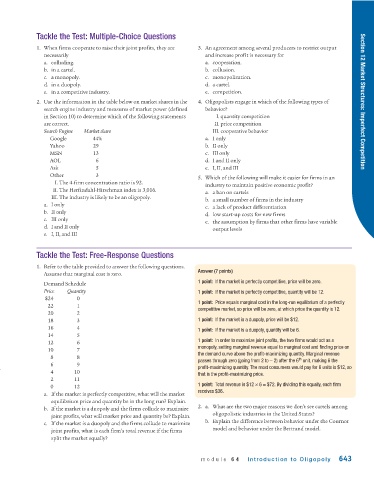Page 685 - Krugmans Economics for AP Text Book_Neat
P. 685
Tackle the Test: Multiple-Choice Questions
1. When firms cooperate to raise their joint profits, they are 3. An agreement among several producers to restrict output
necessarily and increase profit is necessary for
a. colluding. a. cooperation.
b. in a cartel. b. collusion.
c. a monopoly. c. monopolization.
d. in a duopoly. d. a cartel.
e. in a competitive industry. e. competition.
2. Use the information in the table below on market shares in the 4. Oligopolists engage in which of the following types of Section 12 Market Structures: Imperfect Competition
search engine industry and measures of market power (defined behavior?
in Section 10) to determine which of the following statements I. quantity competition
are correct. II. price competition
Search Engine Market share III. cooperative behavior
Google 44% a. I only
Yahoo 29 b. II only
MSN 13 c. III only
AOL 6 d. I and II only
Ask 5 e. I, II, and III
Other 3
5. Which of the following will make it easier for firms in an
I. The 4-firm concentration ratio is 92.
industry to maintain positive economic profit?
II. The Herfindahl-Hirschman index is 3,016.
a. a ban on cartels
III. The industry is likely to be an oligopoly.
b. a small number of firms in the industry
a. I only
c. a lack of product differentiation
b. II only
d. low start-up costs for new firms
c. III only
e. the assumption by firms that other firms have variable
d. I and II only
output levels
e. I, II, and III
Tackle the Test: Free-Response Questions
1. Refer to the table provided to answer the following questions.
Answer (7 points)
Assume that marginal cost is zero.
Demand Schedule 1 point: If the market is perfectly competitive, price will be zero.
Price Quantity 1 point: If the market is perfectly competitive, quantity will be 12.
$24 0
1 point: Price equals marginal cost in the long-run equilibrium of a perfectly
22 1
competitive market, so price will be zero, at which price the quantity is 12.
20 2
18 3 1 point: If the market is a duopoly, price will be $12.
16 4 1 point: If the market is a duopoly, quantity will be 6.
14 5
12 6 1 point: In order to maximize joint profits, the two firms would act as a
monopoly, setting marginal revenue equal to marginal cost and finding price on
10 7
the demand curve above the profit-maximizing quantity. Marginal revenue
8 8
th
passes through zero (going from 2 to − 2) after the 6 unit, making 6 the
6 9
profit-maximizing quantity. The most consumers would pay for 6 units is $12, so
4 10 that is the profit-maximizing price.
2 11
0 12 1 point: Total revenue is $12 × 6 = $72. By dividing this equally, each firm
receives $36.
a. If the market is perfectly competitive, what will the market
equilibrium price and quantity be in the long run? Explain.
b. If the market is a duopoly and the firms collude to maximize 2. a. What are the two major reasons we don’t see cartels among
joint profits, what will market price and quantity be? Explain. oligopolistic industries in the United States?
c. If the market is a duopoly and the firms collude to maximize b. Explain the difference between behavior under the Cournot
joint profits, what is each firm’s total revenue if the firms model and behavior under the Bertrand model.
split the market equally?
module 64 Introduction to Oligopoly 643

